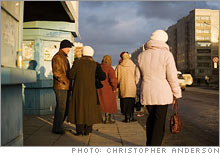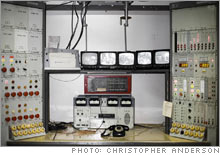The next Silicon Valley: SiberiaA tech boom is giving life to a former Soviet center for science. IBM, Intel - and even Oprah - are paying attention.(Fortune Magazine) -- Time passes slowly in Novosibirsk. In front of the opera house on Red Prospect, skateboard kids skid off the plinth of the Lenin statue. The tilting chimneys of roadside hovels, rusted auto husks and sludge-slicked bus shelters appear to have been slouching into poses over many decades. At the boat hotel on the Ob River, the cook does not hurry with the kasha. The capital of Siberia, Russia's third-largest city, Novosibirsk in winter offers few explicit charms.
But travel beyond the casinos of downtown, past wild dogs patrolling wild weeds, past Tajik road crews in orange jump suits, and a hub of activity rises from the woodland. Here, capitalist opportunity has overcome post-Soviet drear. This is Akademgorodok - Academy Town - where Russian high tech booms. This place, called the Silicon Forest, won't pass for Silicon Valley anytime soon. Private high tech has expanded from a $10 million business a decade ago to a still-tiny $150 million industry last year, with the number of firms growing 15 percent annually. But there is enough softly priced expertise for Intel (Charts), IBM (Charts), and Schlumberger (Charts) to make camp here. And in a signal of Akademgorodok's broadening reach and legitimacy, a local IT firm is producing a Web portal for Oprah Winfrey. President Vladimir Putin has also taken note, backing the construction of a $650 million technology business district with $100 million in state funding for infrastructure. "We simply mustn't waste this chance," Putin declared in Akademgorodok following a 2005 trip to tech-savvy India, "especially as other countries have achieved success without such a strong starting position." High tech is the sort of thing that the Kremlin, realizing that Russia's natural resources can't last forever, would like to develop. Tapping brain resources, then, becomes a priority. Every year, Russia graduates as many science and technology specialists as India - 200,000 - although Russia is 80 percent smaller by population. Russian science and technology hold a unique position in the world, with a tradition of critical thinking and developmental breakthrough, along with a professional hunger born of the proximity to actual hunger. Russia's software exports total $1.8 billion annually; the country is the third-largest software-outsourcing destination in the world, after China and India. "Inside Intel we have an expression," says Steve Chase, president of Intel Russia. "If you have something tough, give it to the Americans. If you have something difficult, give it to the Indians. If you have something impossible, give it to the Russians." The rise and fall of Science Town The story begins in 1958, when leaders in the Soviet scientific establishment secured Nikita Khrushchev's backing to establish a town devoted entirely to science. The idea was to collect many of the country's top scientists in a single location deep in the Siberian woods, far from prying eyes and metropolitan distractions. By 1963 building crews had completed Akademgorodok, a scholastic and research entity 20 miles from the Novosibirsk city center. Within a few years Novosibirsk State University had opened, and its graduates plugged into one of the dozens of surrounding institutes dedicated to advanced research - a Soviet approximation of Cambridge, Mass. In much of the world, moving to Siberia would not be regarded as especially attractive. But this is just what many of the Soviet Union's greatest scientific minds decided to do, to a large extent willingly, lured by the promise of new housing and professional advancement. For 30 years Novosibirsk was one of the smartest cities in the imperium, a collective of academics who put their minds to everything from nuclear physics to theoretical genetics, from the space program to the weapons aimed at the great American evil. And then the bottom dropped out. When the Soviet state collapsed in 1991, the scientific apparatus crumbled along with it. The salaries and status allotted to scientists vanished, as did a system geared toward nourishing young talent. A walk through the Novosibirsk Institute of Automation and Electrometry is all it takes to see the years of neglect. Electrical wires hang from the ceiling like stray hairs across a tired forehead. Paint flakes from the walls; lights in the passageways flicker from dim to dark. For an institution that once sparred with MIT, this place could use a pick-me-up. But when Mikhail Lavrentyev, a Siberian mathematician of lofty provenance, opens the door to a research lab, he reveals what is saving Akademgorodok from sliding into irreversible institutional decrepitude: two doctoral students hunched over computer terminals writing code for Intel. "Akademgorodok was a new idea, multidisciplinarian, to give young scientists a real chance to develop ideas," says Lavrentyev, whose grandfather, also Mikhail, was the prime mover in creating Akademgorodok. "But salaries in the '90s went south. There became a clear choice when you finished your degree: Go to science, or go to business and immediately have a reasonable salary." |
Sponsors
|




